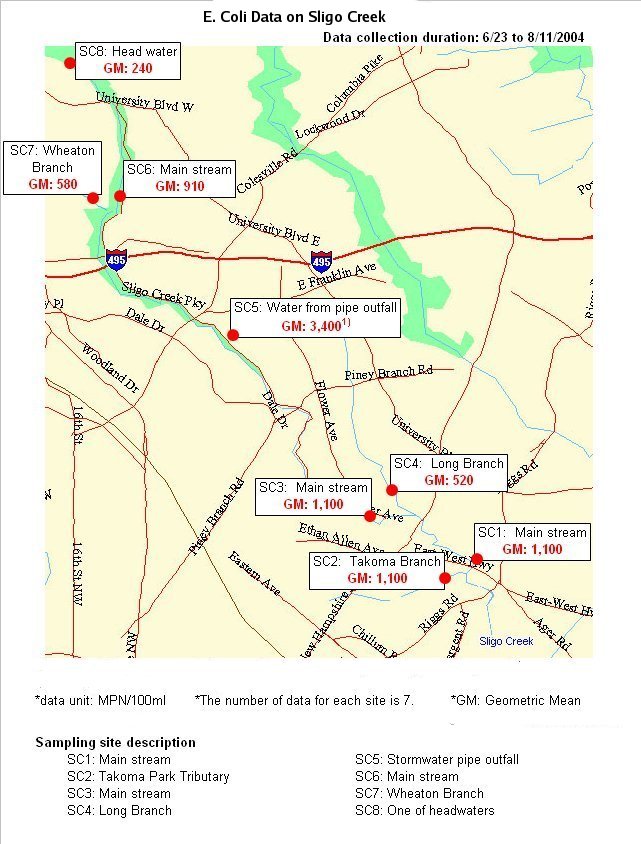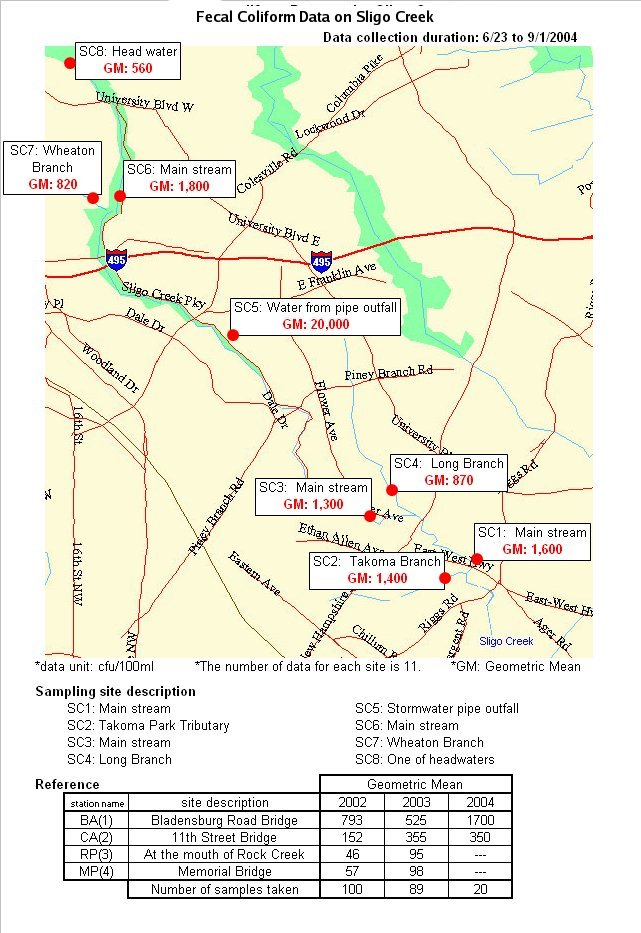
|

|
Anacostia Watershed Society Bacteria Monitoring in Sligo Creek 2004-2005
|
In the summer of 2004, the Anacostia Watershed Society sampled Sligo Creek for the presence of E. coli and other fecal coliform bacteria, both common bacteria originating from sources such as sewer leaks and the feces of animals (geese, dogs. etc.). The results can be seen in the images below.
E. coli
Escherichia coli (E. coli) is a species of fecal coliform bacteria that
comes specifically from the fecal material of warm blooded animals including
humans. EPA studies showed a high correlation between gastroenteritis
(digestive tract illness) and high E. coli counts at swimming areas;
therefore, E. coli is recommended as a good indicator of health risk from
water contact in freshwater recreation areas.
The Maryland state regulations for Use I waters such as Sligo Creek sets the steady state geometric mean indicator density for E. coli bacteria at 126 or less. This should be based on at least five samples taken representatively over 30 days. Thus this image indicates that all tested sites exceeded Maryland state regulatory levels.

1) Almost all of the results at SC5 were greater than the highest number in the test
analysis range. When the test analysis range was 0-2400, the results
exceeded 2400; when 0-4000, the results exceeded 4000. This being the
case, the maximum number in the test analysis range was used to generate the
geometric mean (ie, 2400 when the analysis range was 0-2400, 4000 when
0-4000). This means the calculated result of 3400 is likely to be
significantly lower than the actual geometric mean at the SC5 site.
Fecal coliform
Coliforms are bacteria that commonly inhabit the intestines of humans and
other vertebrates; however, they may also be found in the environment in
soil and submerged wood. Fecal coliforms are types of coliform bacteria
more specific to feces. Fecal coliform used to be the principal bacteria
indicator of health risk for recreational waters until fairly recently, when
the EPA began recommending E. coli as a better indicator of health risk.

Update
Because of the high levels of fecal coliform found coming from the pipe outfall at SC5, the Anacostia Watershed Society
(AWS) attempted further testing in December 2004 with DNA analysis to determine if more of the fecal bacteria derived from humans, pets, or wildlife. However, the water was found to be chlorinated and this interfered with these tests, as the bacteria cannot survive in chlorinated water.
The Montgomery Department of Environmental Protection (DEP) then investigated and found an illegal connection from a condominium building pool drain and a leak from a nearby
fire hydrant. The fire hydrant may be the source of the chlorinated water and the drain from a foot shower the source of the high fecal coliform levels. The sources are not confirmed.
As a result of the DEP's enforcement the fire hydrant leak and illegal connection were fixed.
After the leak was fixed, the flow amount in the stormwater pipe decreased dramatically and became negligible. The AWS and DEP waited for rainfall to flush any legacy
bacteria and chlorine remaining in the system; then they sampled jointly on September 13, 2005. They tested the same samples and their results were found to be consistent.
 |
| Date | Fecal coliform (cfu/100ml) |
| 6/14/2005 | 3100 |
| 8/2/2005 | 5500 |
| 8/16/2005 | 4100 |
| 8/23/2005 | 9400 |
| 9/13/2005 | 1800 |
| 10/18/2005 | 1300 |
| 10/26/2005 | 2000 |
Results of AWS testing at SC5 in 2005
|
During the September 13, 2005 joint testing by the AWS and DEP, the carcass of a dead cat was found just in front of the stormwater pipe outfall.
This was the only test date it was present. The sample 002A was contaminated from the
carcass. The water from the pipe outfall was not contaminated from the
carcass and showed the result of 1,800 cfu/100ml, which was low
compared to the consistently high number observed in 2004 (20,000
cfu/100ml, mean value).
AWS did further follow up testing for fecal coliform on October 18 and 26, 2005. Though the level was still high, it decreased dramatically from the amount detected in 2004.
Moreover, the flow amount became almost zero during sunny days. The Anacostia Watershed Society representative judged the bacteria load (concentration*flow amount)
as an assimilable level to Sligo Creek and closed this case.






